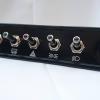Posted 05 November 2008 - 05:23 PM
All the above is correct. However, I'll add a caveat or two.
The common factory install uses mild steel studs for the thermostat housing with nuts on the top. On older cars (and in particular ones where the thermostat has been leaking) it's common for corrosion to seize the alloy thermostat housing to the studs. It would not be a bad idea to either have a new thermostat housing in advance... or at least know in advance where you can get one without driving.
Loosen the nuts on the studs, tap the side of the thermostat flange to break it free, then try lifting it straight up. If it doesn't want to move, spray some penetrating oil on the studs around the holes, refit the nuts to protect the ends of the studs, and tap the nuts with a hammer to shock the oil into the joint. Allow some time for the oil to wick in, then tap the flange again and try lifting. If this still fails, take a sharp chisel and position it at the joint between the housing and the cylinder head. Put the flat side of the chisel against the head and gently tap the chisel in spots around the housing to ease it upward. Gentle taps only. Then try lifting again. Under no circumstances should you pry or lift on the outlet neck of the housing... it will crack.
None of this may be necessary. The housing may come right off. However, you should be mentally prepared for it to be seized and you should locate a replacement thermostat housing in advance... just in case you have to shatter the old one to get it off. They are not expensive.
















